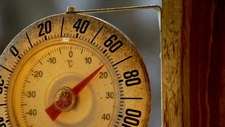Weather Tools

TEKS Objective
The student is expected to collect, record, and compare information using tools, including computers, hand lenses, rulers, primary balances, plastic beakers, magnets, collecting nets, notebooks, and safety goggles; timing devices, including clocks and stopwatches; weather instruments such as thermometers, wind vanes, and rain gauges; and materials to support observations of habitats of organisms such as terrariums and aquariums.
Essential Understanding
The student uses age-appropriate tools and models to investigate the natural world.
Science Background
What are Weather Observations? American Geological Institute (website) - Students learn about different elements of weather, how and why we observe and measure weather conditions, and how this information is used to predict the weather. (Click the arrows to navigate from page to page.)
What are Weather Observations?
American Geological Institute, www.k5geosource.org
Temperature: Environmental Literacy Council (website) - Extensive background information on temperature and how it relates to weather.
Temperature
Environmental Literacy Council, www.enviroliteracy.org
Signature Lesson
Weather Experiments: Weather WizKids (website) - Students build and use simple weather tools (see links for making a thermometer, anemometer, windsock, etc.) to collect, measure, record and compare local weather information.
- Supporting Lessons
- Extensions
- Assessment Ideas
- Literature Connections
- Related
TEKS - Additional Resources
Supporting Lessons
How to Make an Anemometer: Southeast Regional Climate Center (website) - Easy, clear instructions for making an anemometer.
How to Make an Anemometer
Southeast Regional Climate Center, www.sercc.com
Elaboration Lessons and Extensions
Make a Rain Gauge: Weather Wizkids (website) - Simple directions for creating a rain gauge.
Assessment Ideas
Instruments That Measure Weather: National Geographic (PDF) - Students match descriptions of weather instruments to images of those instruments or of weather conditions that the instruments measure.
Instruments That Measure Weather
National Geographic, www.education.nationalgeographic.com
Literature Connections
Weather Forecasting. Sievert, Terri (ISBN-13: 978-0736837392)
What’s the Weather Today? Fowler, Allan (ISBN-13: 978-0516449180)
Cloudy with a Chance of Meatballs. Barrett, Judi (ISBN-13: 978-0689707490)
Weather Words and What They Mean. Gibbons, Gail (ISBN-13: 978-0823409525)
Who Cares About the Weather? Berger, Melvin (ISBN-13: 978-1567840049)
Additional Resources
The Weather Channel Kids: The Weather Channel (website) - This site, designed specifically for students, will help your class to learn about weather and how to measure it.
The Weather Channel Kids
The Weather Channel, www.theweatherchannelkids.com
TEKS Navigation
Grade 2
Need Assistance?
If you need help or have a question please use the links below to help resolve your problem.

Comments